Rukam
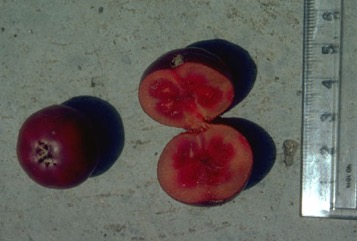
A tropical plant. It grows in humid tropical conditions. It can grow in shade as well as full sun. They occur in Benguet to the southern parts of the islands of the Philippines. Trees occur in tall lowland rainforest. They probably grow from sea level up to about 1600 m in Papua New Guinea. In Samoa it grows from 50 to 550 m altitude. It suits hardiness zones 10-12. In Yunnan.
Also known as:
Aganas, Amaiit, Bitongol, Chemechong, Filimoto, Firmoto, Ganda rukem, Hong quan, Indian prune, Kalominga, Kaluminga, Ken, Khrop-dong, Klang tatah kutang, Kupa landak, Meptengkek, Mung guan ru'ung, Pohon rukem jambon, Rokam, Rukam bubur, Rukam gajah, Rukam manis, Rukem, Ta khop thai, Takho-thai, Tepetatah, Ukam
Synonyms
- Flacourtia edulis Griff.
- Flacourtia euphlebia Merr.
- Flacourtia megaphylla Ridl.
- Flacourtia peninsula Elm.
- Flacourtia rukam var. domestica Ridl.
- Flacourtia rukam var. erythrocarpa Ridl.
- Flacourtia rukam var. micronesica Fosberg & Sachet
- Flacourtia rukam var. myriantha Merr.
- Flacourtia sulcata Elm.
- Hisingera grandifolia Turcz.
Edible Portion
- Leaves, Fruit
Where does Rukam grow?
Found in: Africa, American Samoa, Asia, Australia, Cambodia, China, Chuuk, Cook Islands, Cuba, East Africa, East Timor, Fiji, India, Indochina, Indonesia, Laos, Malaysia, Micronesia, Pacific, Palau, Papua New Guinea, PNG, Philippines, Pohnpei, Rotuma, Samoa, Sarawak, SE Asia, Singapore, Solomon Islands, Taiwan, Thailand, Timor-Leste, Tonga, Vanuatu, Vietnam, Wallis and Futuna
Notes: There are about 17 Flacourtia species. Also put in the Flacourtiaceae family.
Status: In Papua New Guinea, trees occur but are not very common in coastal areas.
Growing Rukam
Cultivation: Trees are mostly self sown. They grow from seed. Seed germinate quickly and easily. Trees can be grown from seed or root suckers. Root suckers are commonly produced. Fruit are made sweeter by rubbing them after harvest. Trees can also be budded or grafted. Trees are spaced 8-12 m apart.
Edible Uses: The fruit are eaten raw when ripe. The fruit are rolled between the hands to reduce the astringency. It can be sour and is used for jam, sauce or pickles. The young leaves and shoots are edible. The young roots are edible.
Production: Fruiting is seasonal. There can be several flowering and fruiting flushes during the year. Fruit are often produced about September to November in the southern hemisphere. Fruit take 14 weeks to ripen.
Nutrition Info
per 100g edible portion| Edible Part | Energy (kcal) | Protein (g) | Iron (mg) | Vitamin A (ug) | Vitamin c (mg) | Zinc (mg) | % Water |
|---|---|---|---|---|---|---|---|
| Fruit | 83 | 1.7 | - | - | - | - | 77 |
Rukam Photos

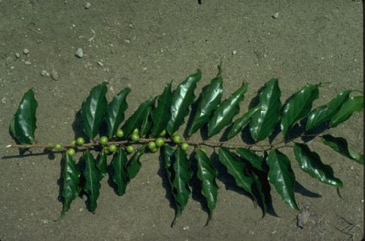
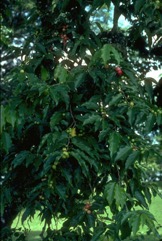
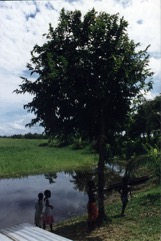
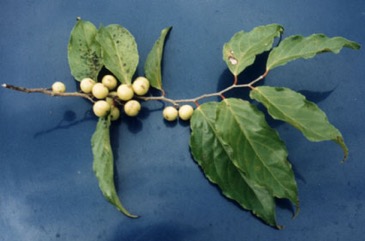
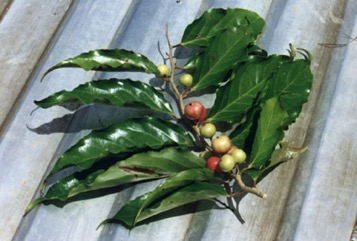
References
Rukam references Flacourtia rukam
Alegado, A. M. & De Guzman, R. B., 2014, Indigenous food crops of the Aetas tribe in the Philippines and their traditional methods of food preparation. in Promotion of Underutilized Indigenous Food Resources for Food Security and Nutrition in Asia and Pacific. FAO. Bangkok p 160
Arora, R. K., 2014, Diversity in Underutilized Plant Species - An Asia-Pacific Perspective. Bioversity International. p 71
Barcelo, R., 2015, Phytochemical Screening and Antioxidant Activity of Edible Wild Fruits in Benguet, Cordillera Administrative Region, Philippines. Electronic Journal of Biology, 2015, Vol.11(3): 80-89
Brown, W.H., 1920, Wild Food Plants of the Philippines. Bureau of Forestry Bulletin No. 21 Manila. p 122
Burkill, I.H., 1935, A Dictionary of the Economic Products of the Malay Peninsula. p 1040-1041.
Chai, P. P. K. (Ed), et al, 2000, A checklist of Flora, Fauna, Food and Medicinal Plants. Lanjak Entimau Wildlife Sanctuary, Sarawak. Forestry Malaysia & ITTO. p 167
Christopherson, E, .,1935, Flowering Plants of Samoa. Flacourtia rukam Bernice P. Bishop Museum Bulletin 128. pp. 151-152.
Chua-Barcelo, R. T., 2014, Ethnobotanical survey of edible wild fruits in Benguet, Cordillera administrative region, the Philippines. Asian Pac. J. Trop. Biomed. 4(Suppl. 1):S525-S538
Corner,
Coronel, R.E., 1982, Fruit Collections in the Philippines. IBPGR Newsletter p 10
Cowie, I, 2006, A Survey of Flora and vegetation of the proposed Jaco-Tutuala-Lore National Park. Timor-Lests (East Timor) www.territorystories.nt/gov.au p 48
Cundall, P., (ed.), 2004, Gardening Australia: flora: the gardener's bible. ABC Books. p 606
Darley, J.J., 1993, Know and Enjoy Tropical Fruit. P & S Publishers. p 132
Delang, C. O., 2007, Ecological Succession of Usable Plants in an Eleven-Year Fallow Cycle in North Lao P.D.R., Ethnobotany Research and Applications. Vol. 5:331-350
Etherington, K., & Imwold, D., (Eds), 2001, Botanica's Trees & Shrubs. The illustrated A-Z of over 8500 trees and shrubs. Random House, Australia. p 330
Facciola, S., 1998, Cornucopia 2: a Source Book of Edible Plants. Kampong Publications, p 117
Forest Inventory and Planning Institute, 1996, Vietnam Forest Trees. Agriculture Publishing House p 311
French, B.R., 1986, Food Plants of Papua New Guinea. A Compendium. Asia Pacific Science Foundation. p 248
French, B.R., 2010, Food Plants of Solomon Islands. A Compendium. Food Plants International Inc. p 242
Gardner, S., et al, 2000, A Field Guide to Forest Trees of Northern Thailand, Kobfai Publishing Project. p 54
Giesen, W., 2013, Paludiculture: sustainable alternatives on degraded peat land in Indonesia (revised draft)
Hariyadi, B., 2008, The Entwined Tree: Traditional Natural Resource Management of Serampas, Jambi, Indonesia. Ph. D thesis. Univ. or Hawaii. p 402
Hu, Shiu-ying, 2005, Food Plants of China. The Chinese University Press. p 564
Jacquat, C., 1990, Plants from the Markets of Thailand. D.K. Book House p 52
Jansen, A. A. J., et al, (Eds), 1990, Food and Nutrition in Fiji. Volume One. p 43
Kitalong, A. H., DeMeo, R. A., & Holm, T., 2013, A Field Guide to the Native Trees of Palau. 2nd edition. USDA p76 (As var. micronesica)
Kiple, K.F. & Ornelas, K.C., (eds), 2000, The Cambridge World History of Food. CUP p 1790
Lembaga Biologi Nasional, 1977, Buah-Buahan, Balai Pustaka, Jakarta. p 110
Liefting, A., et al, Samoan plant names. http://en.wikipedia.org
Macmillan, H.F. (Revised Barlow, H.S., et al) 1991, Tropical Planting and Gardening. Sixth edition. Malayan Nature Society. Kuala Lumpur. p 300
Martin, F.W. & Ruberte, R.M., 1979, Edible Leaves of the Tropics. Antillian College Press, Mayaguez, Puerto Rico. p 192
Miguel, E., et al, 1989, A checklist of the cultivated plants of Cuba. Kulturpflanze 37. 1989, 211-357
Molesworth, A.B., 1967, Malayan Fruits, Donald Moore Press, Singapore. p 59-62.
Monsalud, M.R., Tongacan, A.L., Lopez, F.R., & Lagrimas, M.Q., 1966, Edible Wild Plants in Philippine Forests. Philippine Journal of Science. p 470
A. Moritzi et al., Syst. Verz. 33. 1846
Morton, J. F., 1987, Fruits of Warm Climates. Wipf & Stock Publishers p 318
Ochse, J.J. et al, 1931, Vegetables of the Dutch East Indies. Asher reprint. p 292
Pawera, L., et al, 2020, Wild Food Plants and Trends in Their Use: From Knowledge and Perceptions to Drivers of Change in West Sumatra, Indonesia, Foods. 2020, 9, 1240
Peekel, P.G., 1984, (Translation E.E.Henty), Flora of the Bismarck Archipelago for Naturalists, Division of Botany, Lae, PNG. p 383, 380
Pham-Hoang Ho, 1999, An Illustrated Flora of Vietnam. Nha Xuat Ban Tre. p 541
Priyadi, H., et al, Five hundred plant species in Gunung Halimun Salak National Park West Java. A checklist including Sundanese names, distribution and use. CIFOR, FFPRI, SLU p 149
PROSEA (Plant Resources of South East Asia) handbook, Volume 2, 1991, Edible fruits and nuts.
Saw, L.G., LaFrankie, J. V. Kochummen, K. M., Yap S. K., 1991, Fruit Trees in a Malaysian Rain Forest. Economic Botany, Vol. 45, No. 1, pp. 120-136
Setiyati Sastrapradja (Ed.), 1977, Buah-buahan [Fruits]. Lembogi Biologi Nasional LIPI, Bogor. p110-111.
Sleumer, H., 1954, Flacourtiaceae. In van Steenis, C.G.G.J., (Ed.): Flora Malesiana, Series 1. Vol. 5 pp. 69-77.
Slik, F., www.asianplant.net
Smith, A.C., 1981, Flora Vitiensis Nova, Lawaii, Kuai, Hawaii, Volume 2 p 637
Sunarjono, H.H., Flacourtia rukam in Verheij, E.W.M., and Coronel, R.E., 1991, Plant Resources of South-East Asia. PROSEA No 2 Edible fruits and nuts. p 168-169. PUDOC, Wageningen.
Sukarya, D. G., (Ed.) 2013, 3,500 Plant Species of the Botanic Gardens of Indonesia. LIPI p 295
Suwardi, A. B., et al, 2020, Wild edible fruits generate substantial income for local people of the Gunung Leuser National Park, Aceh Tamiang Region. Ethnobotany Research & Applications 20:11
Suwardi, A. B., et al, 2020, Ethnobotany and conservation of indigenous edible fruit plants in South Aceh, Indonesia. Biodiversitas Vol. 21, No. 5, pp 1850-1860
Terra, G.J.A., 1973, Tropical Vegetables. Communication 54e Royal Tropical Institute, Amsterdam, p 46
Thitiprasert, W., et al, 2007, Country report on the State of Plant Genetic Resources for Food and Agriculture in Thailand (1997-2004). FAO p 95
TodaFruta.com.br
USDA, ARS, National Genetic Resources Program. Germplasm Resources Information Network - (GRIN). [Online Database] National Germplasm Resources Laboratory, Beltsville, Maryland. Available: www.ars-grin.gov/cgi-bin/npgs/html/econ.pl (10 April 2000)
Walter, A. & Sam C., 2002, Fruits of Oceania. ACIAR Monograph No. 85. Canberra. p 173
Whistler, W.A., 2004, Rainforest Trees of Samoa. Isle Botanica Honolulu, Hawaii. p 80
Wiriadinata, H., 1995, Ethnobotany of Economic Plants in the Baliem Valley, Jayawijaya, Irian Jaya, Indonesian Institute of Science, Bogor, Indonesia
World Checklist of Useful Plant Species 2020. Royal Botanic Gardens, Kew
Yuncker, T.G., 1959, Plants of Tonga, Bernice P. Bishop Museum, Hawaii, Bulletin 220. p 191
Zawiah, N. & Othaman, H., 2012, 99 Spesies Buah di FRIM. Institut Penyelidikan Perhutanan Malaysia. p 122